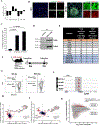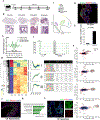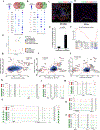Epigenetic basis of oncogenic-Kras-mediated epithelial-cellular proliferation and plasticity
- PMID: 35134344
- PMCID: PMC8938988
- DOI: 10.1016/j.devcel.2022.01.006
Epigenetic basis of oncogenic-Kras-mediated epithelial-cellular proliferation and plasticity
Abstract
Oncogenic Kras induces a hyper-proliferative state that permits cells to progress to neoplasms in diverse epithelial tissues. Depending on the cell of origin, this also involves lineage transformation. Although a multitude of downstream factors have been implicated in these processes, the precise chronology of molecular events controlling them remains elusive. Using mouse models, primary human tissues, and cell lines, we show that, in Kras-mutant alveolar type II cells (AEC2), FOSL1-based AP-1 factor guides the mSWI/SNF complex to increase chromatin accessibility at genomic loci controlling the expression of genes necessary for neoplastic transformation. We identified two orthogonal processes in Kras-mutant distal airway club cells. The first promoted their transdifferentiation into an AEC2-like state through NKX2.1, and the second controlled oncogenic transformation through the AP-1 complex. Our results suggest that neoplasms retain an epigenetic memory of their cell of origin through cell-type-specific transcription factors. Our analysis showed that a cross-tissue-conserved AP-1-dependent chromatin remodeling program regulates carcinogenesis.
Keywords: ATAC-seq; Fosl1; KRAS; NSCLC; adenocarcinoma; alveolar type II cell; club cell; epigenetics; intestinal stem cell; lung.
Copyright © 2022 Elsevier Inc. All rights reserved.
Conflict of interest statement
Declaration of interests X.S. is the co-founder and CEO of Xilis, Inc., a company that develops droplet organoids for clinical diagnostics. This study does not overlap with Xilis’ commercial interests. P.R.T. serves as a consultant for Surrozen Inc., Cellarity Inc., and Celldom Inc., on work not related to the contents of this manuscript.
Figures







Comment in
-
AP-1 leads the way in lung cancer transformation.Dev Cell. 2022 Feb 7;57(3):292-294. doi: 10.1016/j.devcel.2022.01.007. Dev Cell. 2022. PMID: 35134341 Free PMC article.
Similar articles
-
FOSL1 Promotes Kras-induced Lung Cancer through Amphiregulin and Cell Survival Gene Regulation.Am J Respir Cell Mol Biol. 2018 May;58(5):625-635. doi: 10.1165/rcmb.2017-0164OC. Am J Respir Cell Mol Biol. 2018. PMID: 29112457 Free PMC article.
-
An integrative approach unveils FOSL1 as an oncogene vulnerability in KRAS-driven lung and pancreatic cancer.Nat Commun. 2017 Feb 21;8:14294. doi: 10.1038/ncomms14294. Nat Commun. 2017. PMID: 28220783 Free PMC article.
-
Context-Dependent Epigenetic Regulation of Nuclear Factor of Activated T Cells 1 in Pancreatic Plasticity.Gastroenterology. 2017 May;152(6):1507-1520.e15. doi: 10.1053/j.gastro.2017.01.043. Epub 2017 Feb 8. Gastroenterology. 2017. PMID: 28188746
-
KRAS mutation and epithelial-macrophage interplay in pancreatic neoplastic transformation.Int J Cancer. 2018 Oct 15;143(8):1994-2007. doi: 10.1002/ijc.31592. Epub 2018 Aug 9. Int J Cancer. 2018. PMID: 29756386 Free PMC article.
-
Epigenetics as a mediator of plasticity in cancer.Science. 2023 Feb 10;379(6632):eaaw3835. doi: 10.1126/science.aaw3835. Epub 2023 Feb 10. Science. 2023. PMID: 36758093 Free PMC article. Review.
Cited by
-
The potential of activator protein 1 (AP-1) in cancer targeted therapy.Front Immunol. 2023 Jul 6;14:1224892. doi: 10.3389/fimmu.2023.1224892. eCollection 2023. Front Immunol. 2023. PMID: 37483616 Free PMC article. Review.
-
Systematic genetic perturbation reveals principles underpinning robustness of the epigenetic regulatory network.Nucleic Acids Res. 2025 Apr 10;53(7):gkaf297. doi: 10.1093/nar/gkaf297. Nucleic Acids Res. 2025. PMID: 40239999 Free PMC article.
-
AP-1 leads the way in lung cancer transformation.Dev Cell. 2022 Feb 7;57(3):292-294. doi: 10.1016/j.devcel.2022.01.007. Dev Cell. 2022. PMID: 35134341 Free PMC article.
-
Bridging tissue repair and epithelial carcinogenesis: epigenetic memory and field cancerization.Cell Death Differ. 2025 Jan;32(1):78-89. doi: 10.1038/s41418-023-01254-6. Epub 2024 Jan 16. Cell Death Differ. 2025. PMID: 38228801 Review.
-
Pharmacological targeting of the cancer epigenome.Nat Cancer. 2024 Jun;5(6):844-865. doi: 10.1038/s43018-024-00777-2. Epub 2024 Jun 27. Nat Cancer. 2024. PMID: 38937652 Free PMC article. Review.
References
-
- Adamson JS, Senior RM, and Merrill T (1969). Alveolar cell carcinoma: An electron microscopic study. American Review of Respiratory Disease 100, 550–557. - PubMed
-
- Aivado M, Gynes M, Gorelov V, Schmidt W, Röher H, and Goretzki P (2000). “ Field cancerization”--an additional phenomenon in development of colon tumors? K-ras codon 12 mutations in normal colonic mucosa of patients with colorectal neoplasms. Der Chirurg; Zeitschrift fur alle Gebiete der operativen Medizen 71, 1230–1234; discussion 1234–1235. - PubMed
Publication types
MeSH terms
Substances
Grants and funding
LinkOut - more resources
Full Text Sources
Molecular Biology Databases
Miscellaneous

